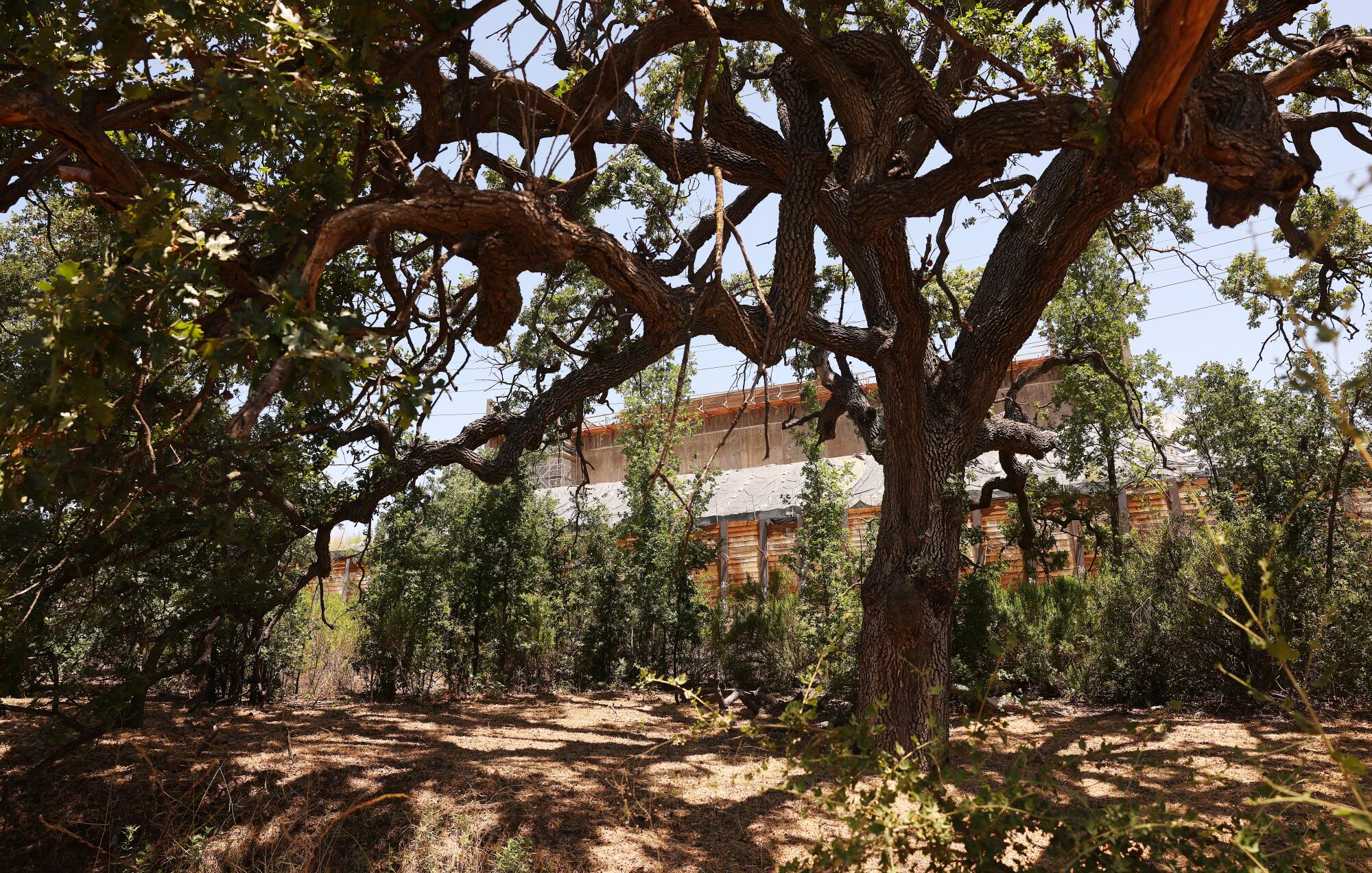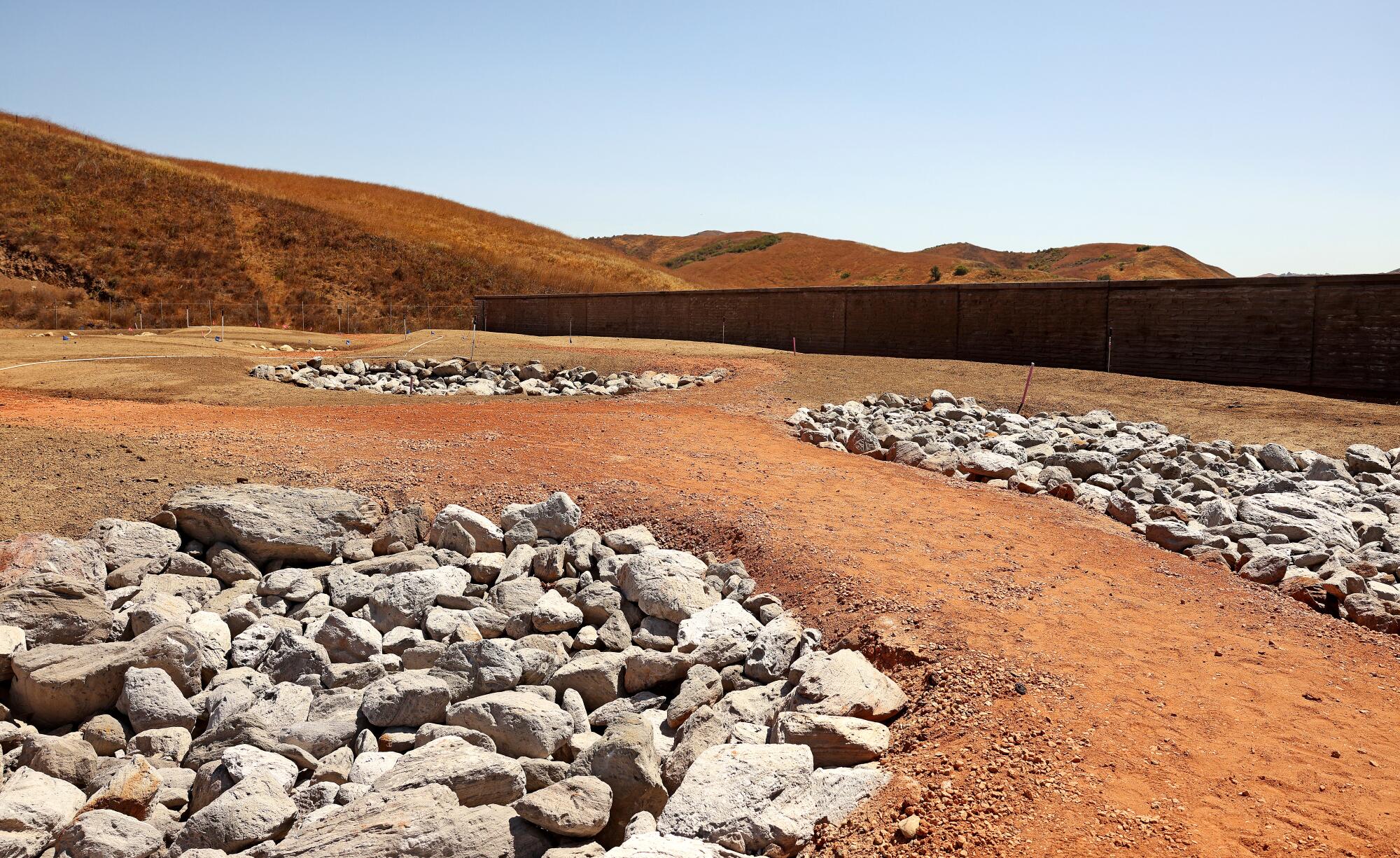Once you’re making an attempt to construct a mountain over one of many nation’s busiest freeways, it’s simple to be envious of unique creation tales, when pure areas had been fashioned with only a wave of the hand.
In these tales, there have been no overhead wires to bury or water strains to maneuver. There weren’t autos to divert, underground creeks that required stabilization, majestic oaks that needed to be saved or soils that required inoculation with native microbes.
However such are the looming challenges for the designers and builders of the Wallis Annenberg Wildlife Crossing, the world’s largest and most formidable crossing designed to present wildlife a protected and nature-mimicking passage over the 10-lane 101 Freeway in Agoura Hills.
The crossing construction itself is generally accomplished — besides the planting, which can occur this fall — however it’s principally a bridge to nowhere proper now, squatting over the freeway simply west of the Liberty Canyon Drive offramp. (Though — information flash! — although it’s not related to the neighboring hills, the primary non-insect wildlife was noticed on the bridge final week: a Western fence lizard basking on the prime, roughly 75 ft above the visitors under.)
The second and last part is putting in the connectors — the construction’s shoulders that can allow freeway-fragmented wildlife to simply cross between the Santa Susana Mountains to the north and the Santa Monica Mountains to the south.
Increasing the areas the place wildlife can safely roam will enhance their probabilities of discovering mates whereas enhancing the well being and genetic range of every thing from lizards to mountain lions like P-22, whose lonely life in Griffith Park helped encourage the crossing.
This second part is the trickiest a part of the mission, particularly the south-side connection over Agoura Street, in response to Robert Rock, chief govt of Chicago-based Rock Design Associates and the panorama architect overseeing the $92.6-million mission.
The Wallis Annenberg Wildlife Crossing connector to the south can be supported by a tunnel over Agoura Street, which can roughly be positioned between the 2 white trailers within the photograph after which threaded (as a lot as attainable) across the small grove of mature oak bushes into the Santa Monica Mountains past.
(Jeanette Marantos)
Work on the south aspect requires burying overhead wires close to the location, shifting water strains for the Las Virgenes Municipal Water District, stabilizing an underground creek (dubbed No-Title Creek) that runs beneath the tunnel web site to forestall erosion after which driving two partitions of pilings deep into the bottom for 175 ft alongside Agoura Street to construct the 54-foot-wide tunnel that can span the highway.
As soon as the tunnel is constructed and the concrete roof is poured, staff will actually be shifting a small mountain of soil from the north aspect of the freeway, the place it was piled when this stretch of the 101 was constructed within the Fifties, to cowl the tunnel and create the sloping connecting shoulder into the Santa Monica Mountains.
The ultimate work can be planting extra native shrubs, perennials and bushes on the shoulders and including two miles of galvanized metal fencing on both aspect of the crossing to funnel animals over the crossing and away from human-made roadways and houses.
Simple peasy, proper? Apart from another element — they must do all this constructing and earth shifting with out disturbing a sprawling grove of native oak bushes rising across the web site.

The designers plan to string their method by way of the small grove of mature oaks on each side of Agoura Street to protect as lots of the mature bushes as attainable when constructing the south shoulder of the crossing over the highway and into the Santa Monica Mountains.
(Christina Home / Los Angeles Instances)
“It’s a difficult pocket,” stated Rock. “We’re undoubtedly threading a needle.”
A number of the smaller bushes could must be eliminated, he stated, however the designers are doing every thing they will to take care of the native bushes rising across the web site. Not shocking, as a result of the entire mission has targeted on re-creating nature as a lot as attainable on a basis of concrete and metal, with native vegetation grown from seeds collected inside a three-mile radius of the mission and soil specifically inoculated with native fungi and microbes to boost their progress. The vegetation are being tended on the mission nursery just a few miles from the location.
C.A. Rasmussen Inc., the Valencia-based contractor who constructed the primary part of the mission, has received the bid to do the second stage as properly, stated Rock. Climate delays — primarily from heavy rains in 2022 and 2023 — have pushed the crossing’s last completion date to the tip of 2026. The state of California has supplied $58.1 million of the $92.6-million mission, as a part of its “30 by 30” purpose to preserve 30% of the state’s lands and coastal waters by 2030. The remainder of the funds are coming from personal donations.
Work on the ultimate part is predicted to start subsequent week. A lot of the prep work and tunnel building would require at the least a partial closure of Agoura Street, however the builders have to present 30 days’ discover earlier than the closures start.

Artist renderings of how the tunnel over Agoura Street and the Wallis Annenberg Wildlife Crossing will look to the south, heading towards the Santa Monica Mountains, when the crossing is accomplished on the finish of 2026. The highest view is going through east on Agoura Street, the underside view is wanting west.
(Rock Design Associates and Nationwide Wildlife Federation)

(Rock Design Associates and Nationwide Wildlife Federation )
The precise closure hours are nonetheless being negotiated with town of Agoura Hills, however Rock stated he expects Agoura Street can be solely partially closed to car and bike visitors throughout daytime hours, when the contractor can be working. The closures are anticipated to start in early August, and final for “a number of months,” he stated.
“I can’t actually say [how long] past a number of months’ value of impacts,” he stated, “however I hope we might be achieved by the tip of the 12 months.”
A couple of vegetation are already starting to develop on the principle construction, from a particular cowl crop of 4 native vegetation hand-sown within the spring — golden yarrow (Eriophyllum confertiflorum), California poppy (Eschscholzia californica), large wildrye (Elymus condensatus) and Santa Barbara milk vetch (Astragalus trichopodus), chosen as a result of they greatest flourished with the mycorrhizal fungi and different microbes added to the soil.
Final week, at the least one invasive black mustard plant was additionally seen on the crossing — not shocking for the reason that surrounding hills had been lush with the fast-growing, simply unfold mustard earlier this spring — however contractors are supposed to maintain these invasive vegetation weeded out, Rock stated, to present the natives an opportunity to get established.
A whole lot of native vegetation that had been grown from seed within the mission’s close by nursery can be planted on the crossing this fall, most likely in October, stated Beth Pratt, California regional govt director of the Nationwide Wildlife Federation and chief of the Save LA Cougars marketing campaign, who’s overseeing funding and fundraising for the mission.

The highest of the Wallis Annenberg Wildlife Crossing resembles a reddish Marscape now, though a canopy crop of native vegetation — California poppy, large wild rye, Santa Barbara milk vetch and golden yarrow — hand sown from seed this spring are beginning to emerge. A whole lot of bigger native shrubs and perennials, grown from seed within the mission’s close by nursery, can be planted on the crossing in October.
(Christina Home / Los Angeles Instances)
Save LA Cougars is promoting a mix of six native seeds supplied by Pacific Coast Seed (previously S&S Seed) for individuals who need bragging rights to rising six of the native vegetation that can characteristic prominently on the crossing — frequent deerweed (Acmispon glaber var. glaber), ashyleaf buckwheat (Eriogonum cinereum), showy penstemon (Penstemon spectabilis), black sage (Salvia mellifera), slim leaf milkweed (Asclepias fascicularis) and foothill needlegrass (Stipa lepida)
You’ll be able to order a packet of the memento seeds on-line for $10. Proceeds will help the mission’s nursery, which is featured in a brand new Save LA Cougars video explaining how all of the crossing’s native vegetation, soils and compost have been chosen and nurtured.
Within the meantime, the latest tariffs have added a brand new funding concern for the mission. It’s not clear but if the mission might want to do extra fundraising to cowl all of the elevated prices, Pratt stated.
“Robert [Rock] and CalTrans have been working across the clock to revamp and value-design to get the prices down, which is why we’re capable of proceed [with Stage 2],” Pratt stated. “The group work has been extraordinary.”
It’s attainable they might want to boost more cash to cowl last bills like the 2 miles of extra-tall fencing that Rock estimates will price round $2 million, however proper now, Pratt stated, the design changes appear to have contained the additional prices. “They received them down once more, so I believe we’re residence free.”
In the meantime, whereas all these human points are unfolding, someplace on prime of the unfinished crossing that Western fence lizard seems to be making a house, although the bare terrain seems like a moonscape proper now. Pratt was main a small group of tourists when she noticed the little reptile, and it took her a second to course of its import.
“I see Western fence lizards on a regular basis in my yard and they’re in all places — some of the frequent animals you will note in California,” Pratt wrote in an electronic mail. “However then it hit me, ‘Wait. This lizard is on the bridge!!!!! And that is the primary animal I’ve seen on the bridge!!!!’ I ended the group … and informed them — ‘You’re seeing the primary animal on the crossing itself.’ Everybody cheered. Even the lizard appeared to realize it was a special day. He posed for the pictures I took.”

